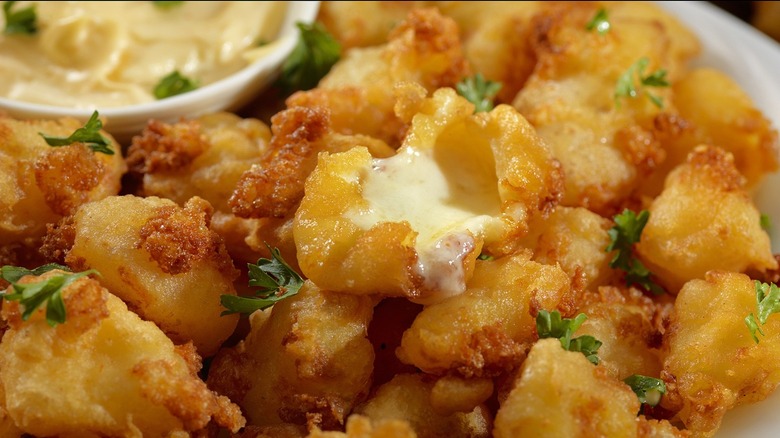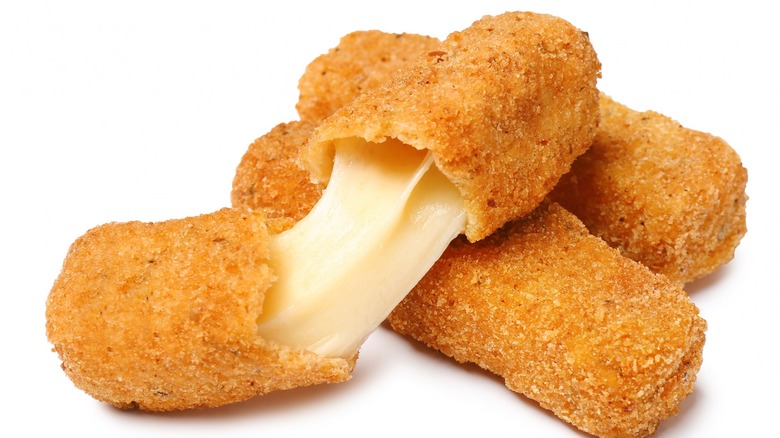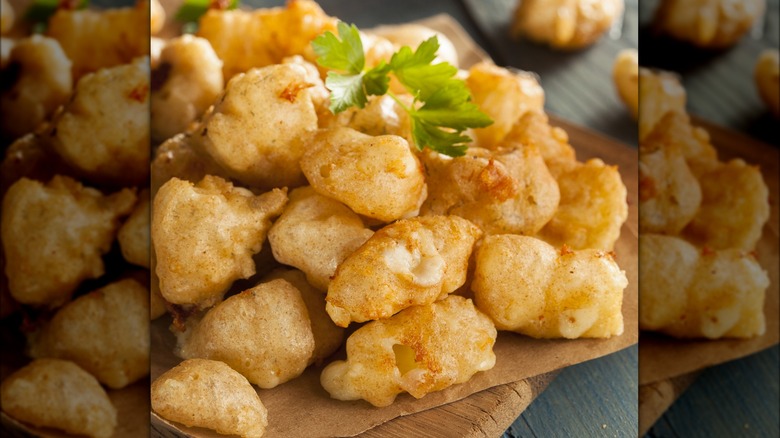Cheese Curds Vs Mozzarella Sticks: What's The Gooey Difference?
It's hard to improve upon perfection, but you can't argue that crunchy breading doesn't take melted cheese to new heights. Take mozzarella sticks, for example. Mozzarella sticks are beloved by many — and for good reason. You'll find them on restaurant appetizer menus everywhere. Yes, they're more common at Italian restaurants, but pubs and other eateries peddle these hot, gooey cheese sticks as well.
Cheese curds, the cousin of this salty, melty cheese snack, don't receive as much notoriety, but that's not because they aren't incredibly delicious. In the Midwest, cheese curds are king. You'll see them way more often in this portion of the United States. The rate of dairy production (and the quality of dairy products) in Midwestern states like Wisconsin has resulted in the state being dubbed "America's Dairyland."
Because these two fried cheese snacks consist of similar ingredients — melted cheese and breading — they're often confused with one another. On the surface, the two items look noticeably different. Mozzarella sticks are served, as the name suggests, in sticks, whereas cheese curds are smaller and more irregular in size than mozzarella sticks. Beyond that, they go through different journeys before reaching their final forms.
How mozzarella sticks are made
When you order mozzarella sticks at a restaurant, it's a predictable experience. You'll receive a serving of melted mozzarella coated in salty, crunchy breading, along with some marinara sauce for dipping. However, before the cheese gets wrapped in that crispy coating and delivered to your table, it has to become mozzarella.
Making mozzarella starts with pasteurizing and coagulating raw milk. This process forms cheese curds, which are mixed with hot water until they can be stretched into long strings. Once the cheesemaker achieves the right texture in the ropes of cheese, the fresh mozzarella is cut into balls and stored in water. The real reason mozzarella is stored in water is because this practice helps the cheese keep its shape and stay moist. Mozzarella cheese has a milky flavor with a touch of sourness, allowing it to pair well with almost anything.
Many consider mozzarella a versatile cheese. Served cold, this cheese makes a wonderful salad topping, or you can also use it as a gooey addition to a panini. It's also a pizza staple with many other uses.
How cheese curds are made
If you're traveling in the Midwest, you shouldn't leave without getting your fill of cheese curds. Whether you eat them fried or fresh, you'll be getting a taste of what this region has to offer. When you take your first bite, you'll notice a slight difference from what you'd experience with mozzarella sticks.
Cheese curds naturally occur during the cheesemaking process. To make them, the process begins the same way as mozzarella — with coagulated milk. This, again, gets heated, causing the cheese curds to pull away from the whey in irregularly shaped chunks. After some time, the curds become somewhat rubbery, a trait you can test for by listening for a squeaky note when you bite into them, denoting their freshness.
Served fried, cheese curds are often mistaken for mozzarella sticks, even though they are smaller and more nugget-shaped. However, their texture is what truly sets them apart. In comparison, cheese curds are more rubbery, hence the squeaking. They also have a similar, slightly tangy flavor profile. Because of their chunky shape and size, cheese curds can hang on to a greater variety of breadings, like tempura or other breadcrumb types. This variation in breading allows cheese curds to pair well with numerous dipping sauces, like ranch or chimichurri.


